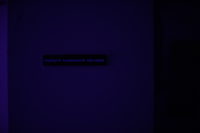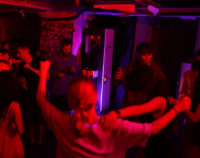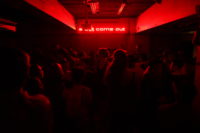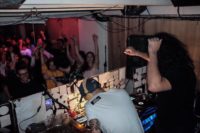In the beginning of the project our discussions mainly involved topics such as the perception of space in urban developments, and the hidden rules and structures embedded in architecture. How does the morphology of a city choreograph our daily behaviour? In which way is the knowledge how to organise space used to control how we move in urban areas from one place to another? What is the feeling of being controlled? When does it feel comfortable and when does it feel uncomfortable? How is it possible to perceive a city from an outside perspective? We talked about different forms of imposing control through architecture, such as the pleasure of playing in a playground.
We soon focused on space design, especially for our first project which would take place in the Hong Kong club, XXX Gallery. The structure of a club is already very strong in its own. There are many unspoken rules, and social laws to abide by. Therefore, the place we hold the exhibition in gives us a structure and helped us to invent a strategy.
COME OUT / OUT COME
How can we hijack and gain control of a party in a club?
We decided on one topic which we minimized in the slogan “come out”/”out come”. We then spread the message all over the club in the form of printed stickers, stamps and LEDs. This was connected to a soundproof booth we build which was located in the middle of the club. There you could enter and watch the party through a peephole, but remained a degree removed from the party crowd. This separation allowed you to see the structure of the system of the party without interacting with it in any way. The muffled sounds and the lack of physical contact with the party that was just inches away created a disconnect and enabled reflection about this system that the viewer was a part of just seconds before. Our beck and call for party goers to “come out”, not only referred to coming out to the party, but also coming out of the booth with a different perspective. It is a call to action, not only a suggestion, to come out with clarity and a voracity for change. Constantly the message is thrown out at the audience members to be as engaged as the messages around them. The “out come” was to create an irritation in which the viewer has experienced the party and understands the rules from an outsider who cannot engage with the party and therefore, upon re-entering the party, realizes the structure of the system and has trouble participating in the same way because of the revelation of unwritten social laws.
Unfortunately, the project didn’t work as well as we anticipated because the connection between the messages of “come out” and “out come” were not as connected to the soundproof booth as we originally hoped.
This was in part because of the many other projects that contributed to the feeling of an exhibition and took a bit away from the rules of the club atmosphere. Because our project was very focused only on the rules of a club, taking away from these rules with various performances created a bit of disconnect that would have been much stronger had our project been only in a club setting. Separately though, our elements created an irritation on their own anyway. Many of the clubgoers were so influenced by our slogan that they thought the title of the evening was “come out”/“out come”. Individuals also had very jarring experiences in our soundproof booth and realized the original intent of our project without connecting the two parts.
INTO THE VOICE
For the second project in The Hong Kong Baptist University: Academy of Visual Arts at the Kai Tak campus we, wanted to adapt this idea of overtaking and creating irritation for a different space. The Kai Tak campus is a heritage site that used to be a police detective school after housing the Royal Air Force, so there is a feeling of control already embedded in the context of the space. We wanted to use this context and connect it to experiences we had in a city like Hong Kong and combine that with our special event, with an apero and the guided tour through the exhibition. For that we decided on a sound installation for which we used several kinds of control with different vocabulary, in different places. Because of the itinerary and structure of the night, we were able to break down the events of the night into welcome message, general rules scattered around the entire campus, apero, and bathroom.
Welcome message:
As an introduction to the hijacking of this event, we wanted to prompt guests with the feeling of the overall control that we hoped to impose on the night. The welcome message greeted guests with the voice of our rules and set the tone for the rest of the inescapable audio they would experience. This was very important to establish our tone of control so that the audience knew that there was no escaping and that there would and always are rules that govern our actions.
Campus walkways/stairs:
Scattered all around the campus, we used more general rules like the ones constantly announced at the MTR stations. We created a disembodied voice that constantly commanded passerbys to obey to generic rules. We still connected to these rules the space by putting them in places of transition, where the purpose of the space is to pass through rather than to stay and chat. As participants were passing by they could decide to obey or not. These rules were the most authoritarian as they were rules that focused primarily on physical actions.
Apero:
In the apero, we addressed the group and made the event itself a subject of the installation. The content of our audio installation highlighted unspoken social conventions and internalized questions, creating a deep irritation within this dinner and party setting. These rules were scattered around the dinner space in at a lower volume and then also in an announcement-like manner with a louder speaker up above the space. These cycled around the party at random intervals as small reminders for individual participants and then up above as a reminder to all guests. The speed of the announcements was just enough that people in the immediate vicinity were constantly reminded of the rules of the apero. This event explored social rules that are learned and broadcasted them into the event in which social rules are used the most.
Bathroom:
There we addressed the individual again and asked questions one should ask if he/she participates in an art/social event. The questions within the bathroom became increasingly personal and critical as the night went on. In an intimate space like a restroom, we wanted participants to reflect internally on both the event and themselves. This area created the most irritation because it imposed questions that dictated the way an individual would view themselves instead of creating rules for the participant to follow. This allowed for self- interpretation, but we phrased the questions in a way that planted seeds of doubt or dismay in their minds rather than imposing rigid structures. This way of control played on the idea of self-censorship and the subtlety of rules and their effectiveness on controlling individuals.
We are really pleased with the result of our installation in Kai Tak. It was very interesting to see how the audience reacts to different forms of control in the different spaces.




